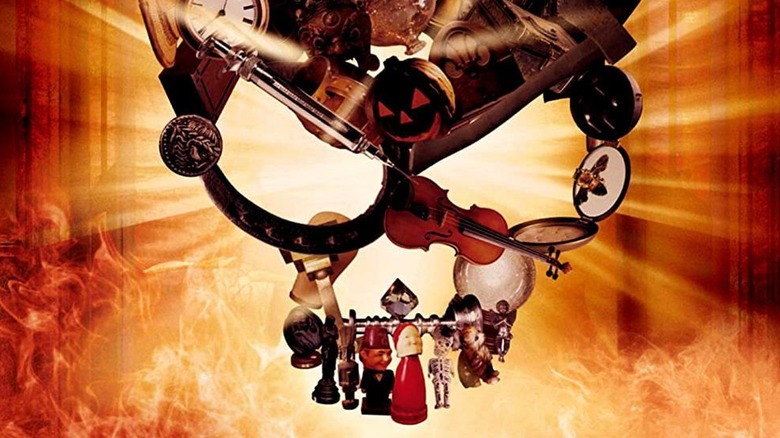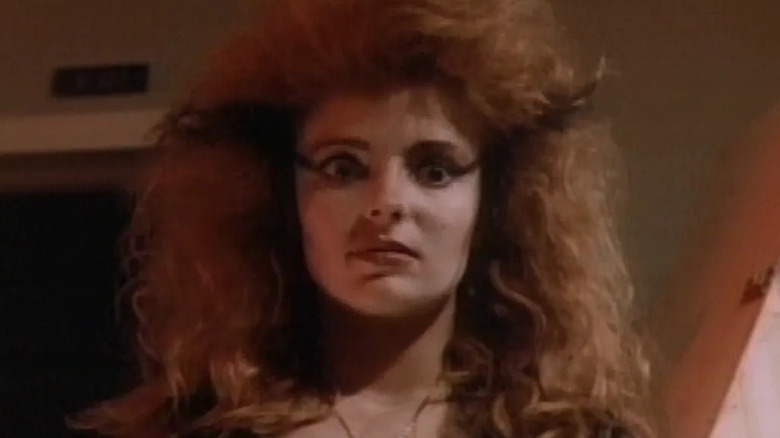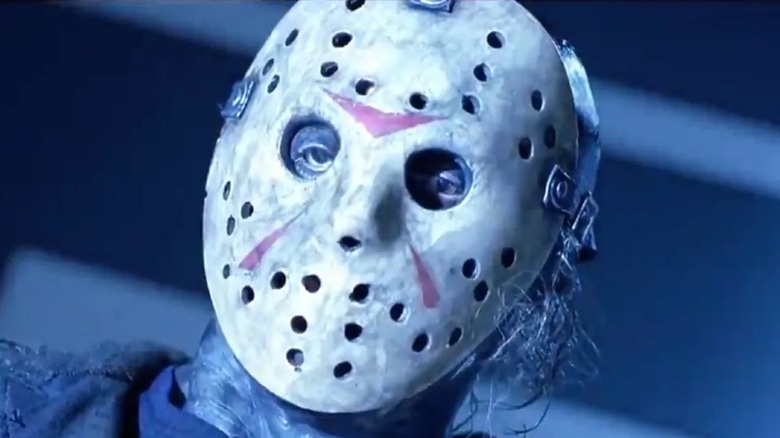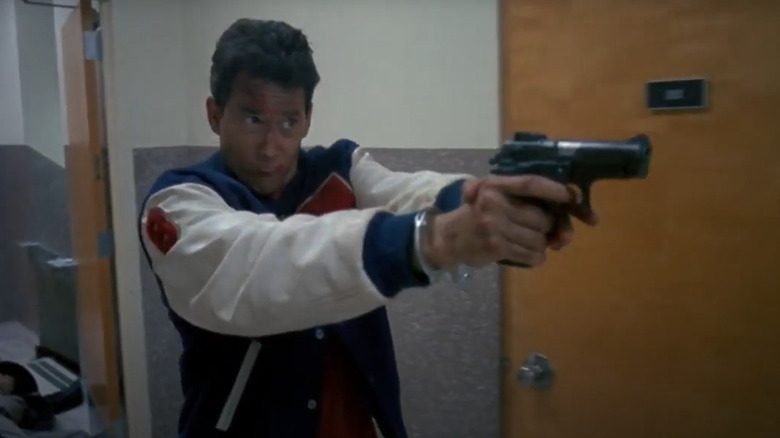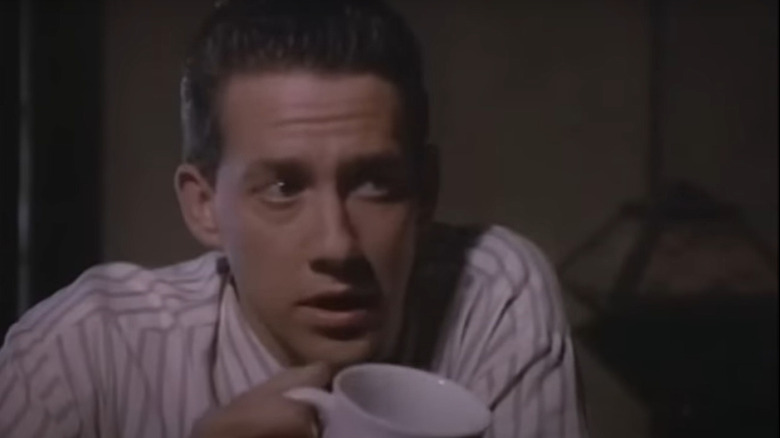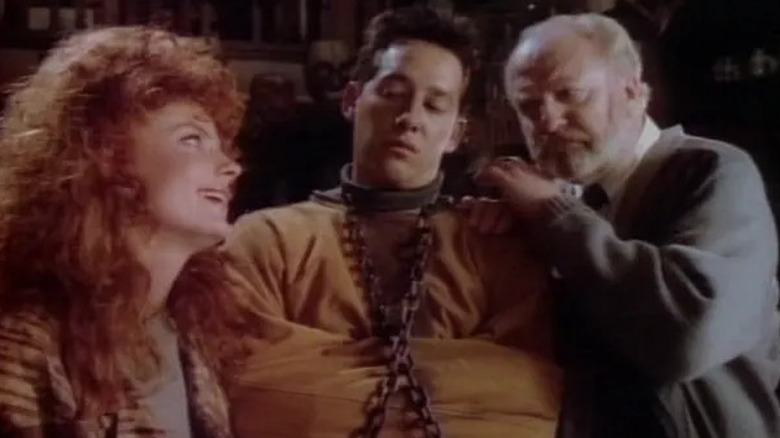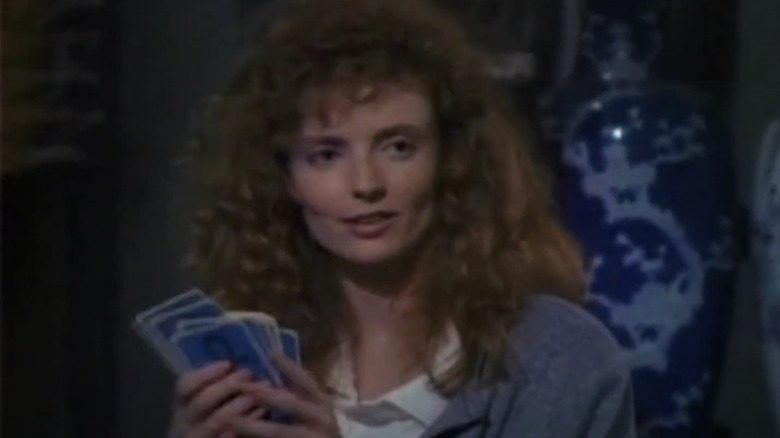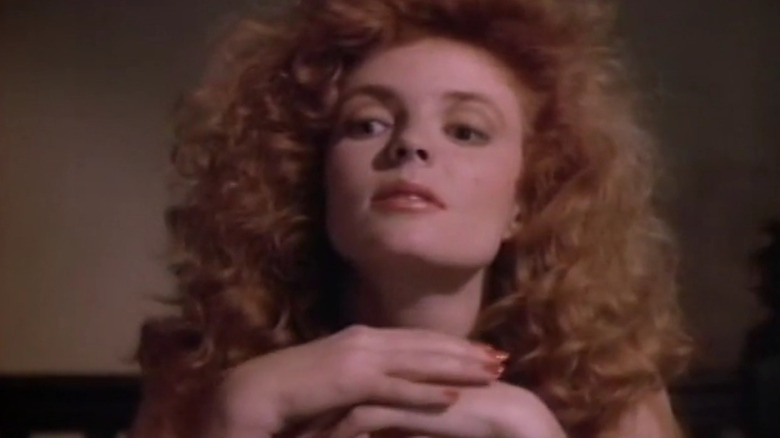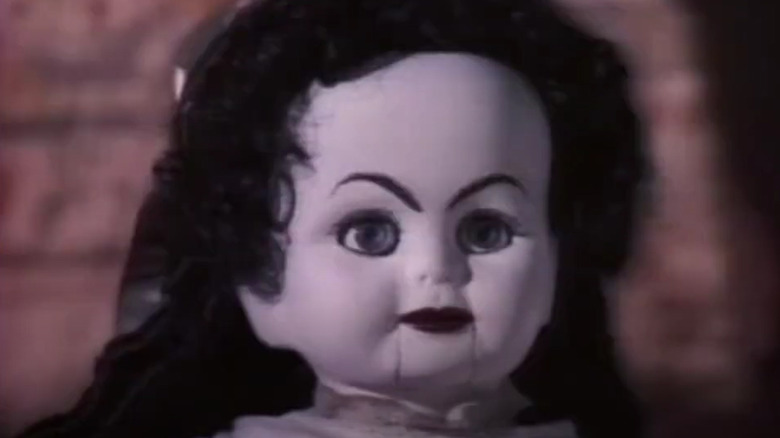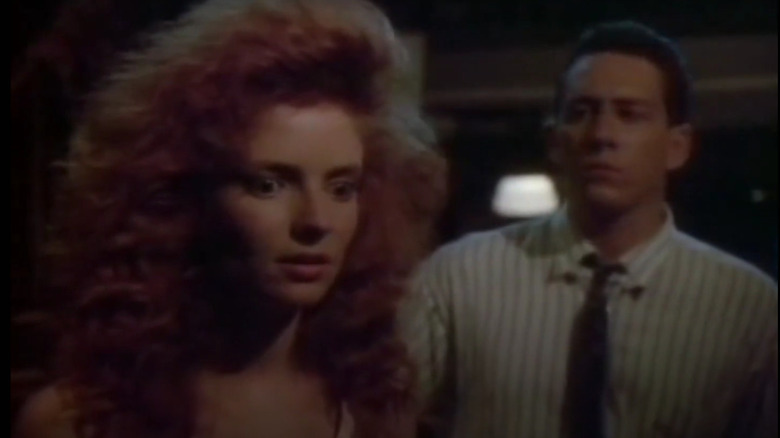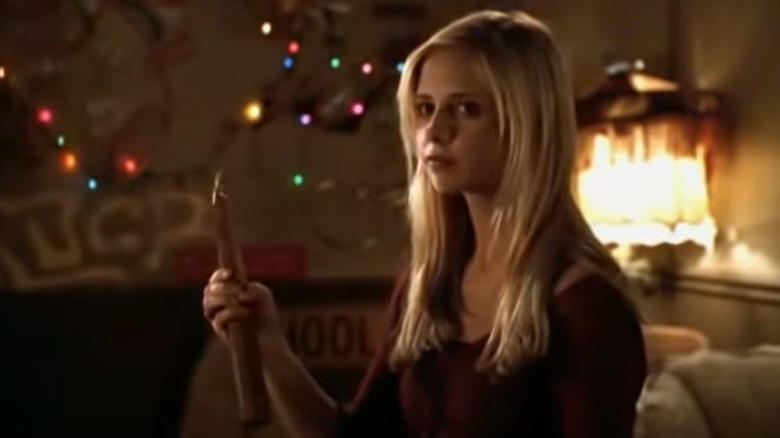Friday The 13th: The Series: The Complete History Of TV's Forgotten Horror Show
Surely, the mention of the title "Friday the 13th" will send most audience members into a fond recollection of the many scares delivered by Jason Voorhees and his ominous mask, terrorizing teens over the course of decades in one of the most memorable horror film franchises of all time. Kicking off in 1980 with the murderous Pamela Voorhees behind the mask and spawning many sequels in which Jason stepped into the role of an unstoppable killing machine, the "Friday the 13th" film series is a true child of the '80s, releasing no less than seven sequels before the decade drew to a close. It only stands to reason that this incredibly popular franchise would inspire a TV show based on the horrors taking place at the notorious Camp Crystal Lake.
Yet, "Friday the 13th: The Series" ... isn't that. Released in 1987 while the theatrical sequels were still going strong, the series introduces a completely new cast of characters interacting with a totally different premise; the name "Voorhees" is never uttered, not even once. Successful for the three seasons, it unceremoniously vanished from the small screen. This is a show perhaps best known for its status as an odd, unrelated tangent that doesn't even remotely tie into the movies it's named after. Still, there's a lot more going on with this show than first meets the eye and, regardless of your thoughts on Jason Voorhees, it might be high time to check out an episode or three.
Behind the scenes...
This show deserves more credit than it gets, not just for the entertainment it provides but for serving as a sort of prototype for a lot of the genre shows that changed television in subsequent years. Still, its story is rarely revisited, which is why just about all of the available information on "Friday the 13th: The Series" comes from the book, "Curious Goods: Behind the Scenes of Friday the 13th: The Series" by Alyse Wax. The book, initially published in 2015, features plenty of interviews with cast and crew, alongside a lot of notes and observations from Wax, who makes clear her status as an avid fan in the book's foreword. For anyone looking to find out more about this quirky little artifact, Wax's book is a must-read.
As for tracking down the show itself, that could very well entail a quest much like the one that Jack, Micki, and Ryan undertook in hunting down the many cursed objects in the show. "Friday the 13th: The Series" is not currently streaming on any official streaming platform, and if you can track down an episode, chances are the quality of the video is not going to be terrific. The show can be bought in its entirety as a DVD boxed set, but even that will take a bit of finagling. With a "Friday the 13th" prequel series on its way via Peacock, it's hard to say if that could inspire increased interest in this unconnected show or if it will only bury it further in the vault. Either way, genre fans will find this series to be worth the time it takes to track it down, regardless of whether they know the lore behind Jason Voorhees and Camp Crystal Lake.
Jason never appears
Without a doubt, the most bizarre thing about "Friday the 13th: The Series" is what doesn't happen. Despite the title, Jason Voorhees never appears, nor does his now-mythical blood-spattered mask. In fact, there is no reference to the killer or his lineage, making this a series sure to stir up resentment from "Friday the 13th" film franchise mega-fans who understandably check out the series hoping for any connection to the films. In an interview in Alyse Wax's book, "Curious Goods: Behind the Scenes of Friday the 13th: The Series," producer Frank Mancuso Jr. explained that Paramount was looking to make a "Friday the 13th" TV series, which didn't interest him ... at first.
"I felt as though I'd kind of done 'Friday the 13th' and I wasn't really interested in revisiting it. I felt like it ultimately was limiting how people perceived what I was capable of," Mancuso said. However, when the executives said that the show could be anything so long as it kept the name, his interest was piqued. "We started thinking about 'The Twilight Zone' and how that had common elements and they were bound thematically but they weren't necessarily a traditional series," he continued. "As such, the name more or less took a backseat to the excitement around what could be done with the series."
Quite a few 'Friday the 13th' alumni stop by
Even without that Voorhees star power behind the show, there are still quite a few familiar faces among the cast and crew. To begin with, Frank Mancuso Jr., who worked on many of the "Friday the 13th" sequels in the '80s as a producer, was the co-creator of the series and served as the executive producer. Later, he would produce unique genre projects like the films "Species" and "Cool World," perhaps incorporating a bit of what he learned on "Friday the 13th: The Series." Other "Friday the 13th" movie series alumni includes Fred Mollin, the composer who also worked on the sequels "The New Blood" and "Jason Takes Manhattan"; Rob Hedden, whose debut work as a writer and director was on "Jason Takes Manhattan"; and Tom McLoughlin, who directed "Jason Lives."
Meanwhile, in front of the camera, the actor who portrayed main character Ryan, John D. LeMay, also starred in "Jason Goes to Hell," while guest star John Shepherd appeared in "A New Beginning." Finally, perhaps the most surprising "Friday the 13th" connective thread is that of director David Cronenberg. Known for body horror masterworks like "The Fly" and "Videodrome," Cronenberg makes an appearance as director of the Season 1 episode "Faith Healer," which features all his trademark goo and grime. Later, he showed up as an actor in the futuristic, over-the-top "Jason X."
The haunted objects premise is absolutely wild
Cursed objects that cause doom and despair to those unfortunate enough to gain possession of them is a tried-and-true genre trope, but "Friday the 13th: The Series" takes it to a whole new level by introducing a whole antique shop full of such items. When Lewis Vendredi makes a deal with the literal Devil to sell these "curious goods" in his shop in exchange for wealth and power, he doesn't know that eventually he'll get fed up with serving the Devil's whims and rebel, only to lose his soul for all eternity. However, with his death, Micki and Ryan inherit the antique store and seek to liquidate the inventory. That is, until Vendredi's friend, Jack Marshak, stops them.
The occultist Marshak explains the importance of these objects to Micki and Ryan, as well as the responsibility they now wield in tracking down any lost items to curb the harm they might otherwise unleash on the world. This idea opens the crew up to dealing with everything from the classic evil doll in the debut episode, "The Inheritance," to a pen capable of turning the written word to reality in "The Poison Pen." Using Vendredi's inventory list and locking these indestructible objects in a vault under the antique shop to prevent further harm becomes Micki, Ryan, and Jack's motivation throughout the series. The premise creates endless scenarios for its cast to sort through and so it never loses steam through its three seasons on air.
The cast makes it work
There is no underselling the three main characters when discussing what works about "Friday the 13th: The Series." Though they don't know each other at the outset, we discover in the first episode that Micki and Ryan are apparently cousins by marriage. The two have quippy, entertaining banter throughout the series, tempered by Jack's sage advice and warnings about the occult objects that they must retrieve. Micki and Ryan tend to be a bit stubborn and full of themselves and regularly try to go their own way only to be forced to rely on Jack's expertise in order to survive. In fact, Micki even dies in the episode, "Tails I Live, Heads You Die," and only Ryan and Jack are able to bring her back.
Ryan is interested in many fields but lacks discipline, while Micki is a bit shallow and stuck in a directionless engagement to a wealthy man named Lloyd at the beginning of the series. Still, their adventures tracking down these strange artifacts not only bring them closer together — their encounters with supernatural horror help them grow as people. Indeed, when John D. LeMay suddenly departed the series, forcing the show to replace Ryan with the character Johnny, the whole series suffered due to the loss of natural chemistry between the characters that's apparent even in the first episodes of the show. Johnny may have clicked if given a bit more time, but there's no denying that the first two seasons thrived by creating a compelling dynamic between the leads that was difficult to duplicate.
It ran for 72 episodes
For a series that only spent three seasons on the air and more or less vanished in the subsequent decades, there is a whole lot of show on the books, with the series clocking in at 72 episodes. This isn't to say that there's no filler at all, as the show ran a "clip show" with "Bottle of Dreams" before the first season had even drawn to a close. Still, even with that, the show makes for a lengthier watch than one might expect, with a surprising number of absolute bangers in the mix. Episodes like "The Inheritance," "Faith Healer," "The Playhouse," and "Scarecrow" aren't just series bests, they can easily stand alongside any other genre shows of the era in terms of characters, concepts, and scares.
Likewise, despite the "monster of the week" format the show follows, it made good use of the apparently somewhat lax oversight from Paramount, delving into some pretty shocking stuff while allowing its characters to move and change as the series progresses. The show also features a lot of surprising names in its credits list over the years, with an appearance from "Women Talking" director Sarah Polley as a very young child in the first episode, "The Inheritance"; Toronto New Wave director Atom Egoyan directing "Cupid's Quiver"; and David Lynch's daughter and "Dahmer – Monster" director Jennifer Lynch popping in to co-write the Season 3 episode, "Repetition." These are only a handful of the famous faces who chipped into TV's "Friday the 13th."
You can't do that on TV
Although TV viewers of today might not be particularly stunned by the violence of the series, there's no denying that it was a rarity for TV of its time, with the Season 2 episode "Better Off Dead" running with a then unheard of "viewer discretion advised" card at the top of the episode.
The extra caution here was certainly warranted — "Better off Dead" features epic gore springing from its premise of a doctor attempting to get to the bottom of "hyper-violence syndrome" through brutal experimentation on human subjects. The show dives headfirst through genre tropes, but even tried-and-true classics like the killer doll of "The Inheritance" features some pretty violent stuff, with the child character Mary likely traumatized for life after the credits roll.
Indeed, there is only one episode of the series with no deaths, and that is "The Playhouse," though the child-oriented story does deal with themes of abuse and sees a fairly bleak ending with Mike and Janine Carlson placed into foster care after the horrific events of the episode. "The Long Road Home" feels like a mini-sequel to "The Texas Chainsaw Massacre" — grisly deaths occur due to everything from dancing to death to overwhelming psychic energy. This is all to say, don't let the time of its airing, nor the lightness of its banter fool you — this is a heavy show that deals with serious violence and genuinely haunting subject matter.
It wasn't an easy series to make
One recurring theme throughout the many interviews in the book "Curious Goods" is that this show was far from easy to make. John D. LeMay expressed regret for leaving the series in the book and said he wished someone had mentored him and urged him to work through the hardest parts of the show. "I wish I had been more mature and understood how to make the experience one I could continually grow from," he told the author. "We learn our lessons the hard way sometimes." However, Louise Robey countered that, "I secretly was sort of happy about [the show ending] because I was fed up."
Robey went on to explain that the shoots were a bit excruciating. "You're in hair and makeup, and nothing happens for six hours. And it was often freezing cold. We shot in temperatures that were unbelievable. The extras were being picked off the fields like flies because they were just frozen." Still, even though it wasn't all roses, many people from the crew note in the book that they still cherish some of the "curious objects" from the show. Robey says she kept the doll from "The Inheritance" for a long time before it was shattered in a move, while director and cinematographer Rodney Charters notes that he kept the sword from "Year of the Monkey."
It was canceled out of nowhere
Among the many surprising tidbits about this series, one of the most important is the fact that it was a notable success that went neck and neck with "Star Trek: The Next Generation" in ratings among the "males age 18-49" demographic and fifth for women of the same age group. However, as noted, the show was exceptionally adult oriented in its subject matter, and self-appointed morality crusaders took note. Mancuso recalls in "Curious Goods" that the minister and American Family Association founder Donald Wildmon regularly threatened to use his power to urge sponsors to stop advertising with the series, which would have meant financial doom. According to Mancuso, "I knew that this would be the end of it, even though I was firmly of the belief that this guy had never seen the show."
The final episode of the series ended up being the 20th episode of Season 3, "The Charnel Pit," in which Micki is sent back in time to interact with the Marquis de Sade. Though it's not an exceptionally tidy ending for the series, it is one of the strongest episodes and a top-notch character focus for Micki, who challenges de Sade at his own game and ultimately retrieves the painting she's attempting to track down. According to "Curious Goods," the show was pulled from the air so quickly that episodes in production were halted and it was never given a proper ending, making "The Charnel Pit" an offbeat, if not totally unfitting, conclusion.
It predicted a lot of iconic series
You may have noticed that while its subject matter doesn't cross over much with the film franchise it shares a name with, "Friday the 13th: The Series" does have some plot points that might remind you of other genre hits that came after it left the air. For instance, "Buffy the Vampire Slayer" might be significantly better remembered today, but these two shows have some pretty noticeable similarities in their character dynamics; Micki and Buffy, Ryan and Xander, and Jack and Giles all bear more than passing resemblances to one another. It doesn't approach rip-off territory, but it does make it clear how ahead of its time "Friday the 13th: The Series" truly was in some respects.
The idea of the "cursed object" is all over mythology and even has historical precedent, with many people believing that items like the Hope Diamond, the Tomb of Tutankhamun, and the doll Annabelle to be inherently prone to bringing death and destruction to those unlucky enough to cross their paths. Still, it's become a huge staple of genre TV, with episodes of "Buffy," "The X-Files," and others diving in to share the fun. The Syfy series "Warehouse 13" took the concept and ran with it, and while it would be a stretch to call it an homage, it certainly has some very "Friday the 13th: The Series" vibes for anyone looking to follow up this show with another in the same spirit.
